Coordinación
Una coordinación sólida puede evitar vacíos y duplicaciones en las respuestas humanitarias, así como garantizar que los PTM complementen otros tipos de asistencia. Sin embargo, el informe del «Estado Global de los Programas de Transferencias Monetarias» de la CALP Network muestra que la coordinación de la asistencia en efectivo es vista como débil y ad hoc, y que esto está teniendo graves repercusiones operativas.
Los donantes, las ONG y los líderes de los grupos de trabajo de transferencias monetarias (GTM) han pedido claridad sobre tres temas principales relacionados con la coordinación de la asistencia en efectivo:
- Quién debe ser responsable de asegurar una coordinación eficaz de la asistencia en efectivo;
- Cuál es la función y el mandato de los grupos de trabajo de transferencias monetarias, incluso en relación con las transferencias monetarias multipropósito;
- Cómo se debe dotar de recursos a la coordinación de asistencia en efectivo.
Tenemos que basarnos urgentemente en lo que funciona y proporcionar claridad a nivel mundial sobre las preguntas arriba mencionadas, adaptándonos a los diferentes contextos. Hace mucho tiempo que se deberían haber tomado decisiones claras basadas en necesidades operativas y no en la política de las agencias.
Prioridades actuales
El objetivo de la CALP Network es contribuir a seguir progresando en este tema en tres niveles: apoyar a los grupos de trabajo de transferencias monetarias a nivel regional; contribuir a soluciones prácticas para la coordinación de la asistencia en efectivo a nivel mundial; y convocar una discusión basada en la evidencia sobre temas clave, destacando puntos de decisión críticos y oportunidades de progreso.
Contenido destacado
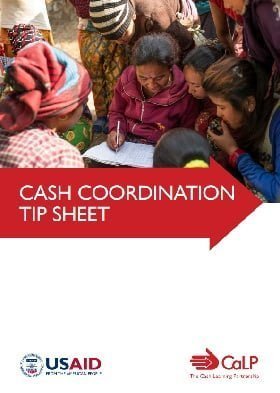
Cash Coordination Tip Sheet
Guidelines and Tools
This tip sheet sets out established best practice, key guidance and resources for all aspects of cash coordination, intended as a clear, accessible and action-oriented guide for those engaged in coordination of cash and voucher assistance (CVA) at the field level.
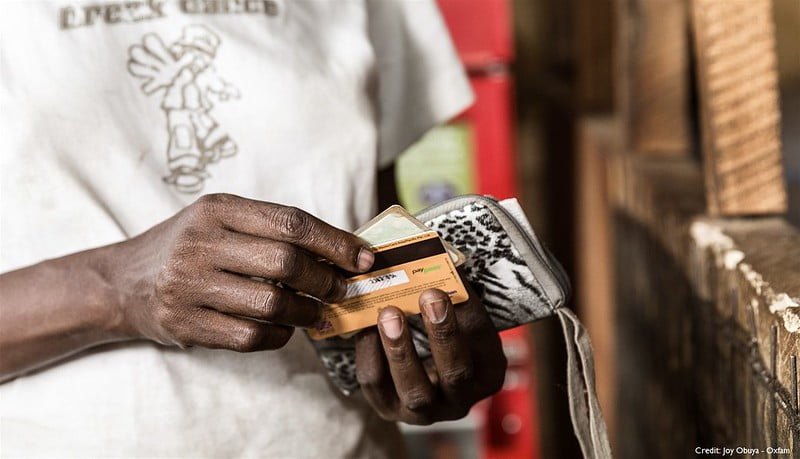
Introducing the Cash Coordination Tip Sheet
Webinar
The CALP Network has developed a tipsheet setting out established best practice and key guidance and resources for all aspects of cash coordination, intended as a clear, accessible and action-oriented guide for those engaged in coordination of cash and voucher assistance at the field level.

Cash Coordination: A proposal from members in MENA
Blog Post
Earlier this year the CALP Network undertook regional consultations to explore options for cash coordination. This blog lays out recommendations from participants from the Middle East and North Africa who sketched out what cash coordination, and coordination more broadly, could look like in future to support a more effective, efficient and accountable response.
Últimos recursos

Mobile Money Transfer: A study on effectiveness and efficacy!
Report
For this study both structured and semi-structured questioning method were used. Few KII (in depth interview) along with a pre-designed questionnaire were used for understanding the benefits and challenges of this new method on different stakeholders.

Meta-Evaluation of ACF Fresh Food Voucher Programmes
Report
ACF commissioned a meta-evaluation of five of its fresh food voucher programmes implemented between 2009-2011 during emergencies in Bolivia, Dadaab refugee camps in Kenya, Haiti, Pakistan and the occupied Palestinian Territories (oPT). The programmes were all paper cash vouchers exchanged for fresh foods...

Haiti – Unconditional Cash Transfers: Lessons Learnt
Report
The challenges of responding to the catastrophic earthquake in Haiti were huge and varied, prompting agencies to think and act creatively. Christian Aid’s partners were at the forefront of the humanitarian response, distributing cash to people affected by the disaster two weeks after the earthquake...

An Emergency Market Mapping and Analysis study Changing Responses to the Haiti Earthquake
Report
Good practice standards guidelines and evaluations all emphasise the importance of including markets in emergency situation and response analysis. While this approach has become more widely accepted by international organisations in recent years, in practice it is clear that support is still needed to...
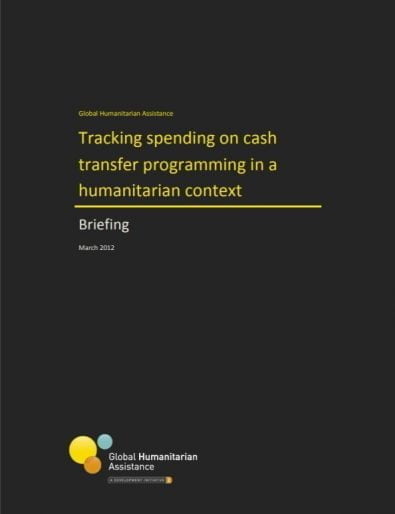
Tracking Spending on Cash Transfer Programming in a Humanitarian Context
Report
This briefing paper provides a brief overview of cash transfers by situating them within official development assistance (ODA) analysis. However, the core of this analysis concentrates on tracking cash transfer programme spending in humanitarian aid. For analysis of cash transfer spending in crisis...

Guidelines: How to use Hawala in Somalia
Guidelines and Tools
Money transfer companies, also known as hawala, are an increasingly popular partner chosen by humanitarian agencies to distribute cash in Somalia. This brief will explain what hawala are, how they operate, and provide some brief guidelines on how agencies can partner with them to deliver cash transfers in...
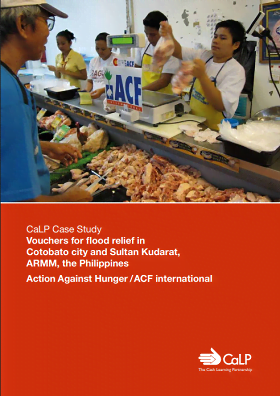
Vouchers for Flood Relief in Cotobato City and Sultan Kudarat, ARMM (Mindanao), the Philippines
Case Study
In response to a rapid-onset emergency, Action Against Hunger / ACF International, with funding from AECID, implemented a cash transfer program in Cotobato City, situated in the Autonomous Region of Muslim Mindanao in the Philippines. The project established a cash voucher program through local...
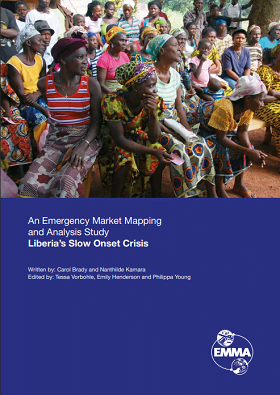
An Emergency Market Mapping and Analysis Study Liberia’s Slow Onset Crisis
Report
In 2010, contested elections in neighbouring Côte d’Ivoire, and the violence that ensued, forced hundreds of thousands of people from their homes. As of 7th of July 2011, the United Nations High Commissioner for Refugees (UNHCR) had counted a total of 153,000 refugees crossing the border into Liberia....
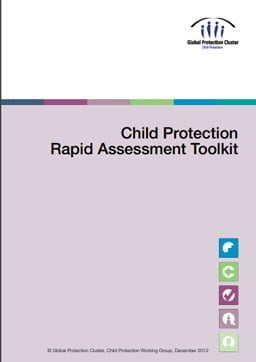
Child Protection Rapid Assessment Toolkit
Guidelines and Tools
The CPRA Toolkit provides all the information you need to conduct a CPRA over a five-week timeframe. The toolkit is divided into three parts: Part 1: a guide to CPRA provides an action plan with 6 key phases, giving guidance for tasks in each phase. Part 2: sample tools provides five key tools for...
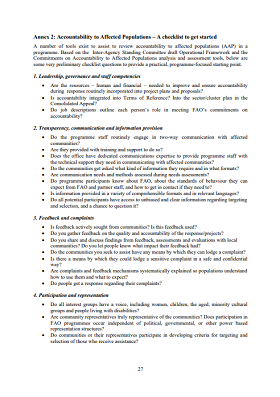
Cash For Work Guidelines
Report
A number of tools exist to assist to review accountability to affected populations (AAP) in a programme. Based on the Inter-Agency Standing Committee draft Operational Framework and the Commitments on Accountability to Affected Populations analysis and assessment tools, below are some very preliminary...

Comparing the Efficiency, Effectiveness and Impact of Food and Cash for Work Interventions: Lessons Learned from South Sudan
Report
In addition to food aid, which used to be the standard response to food emergencies, alternative instruments of food assistance such as cash and vouchers have increasingly been applied in emergency and transition situations in recent years. The subject of the present study was a comparative analysis of...

An Emergency Market Mapping and Analysis study Market Support in South Sudan
Report
Abyei is a relatively small and disputed area of land on the border of North and South Sudan that has, in recent years, experienced much turmoil. Historically, both the governments of South and North Sudan have claimed Abyei and tensions that have existed since before the first Sudanese Civil War...

Market Information and Food Insecurity Response Analysis (MIFIRA) Framework Course
Guidelines and Tools
Access Course Here This course outlines the rationale for “response analysis” and introduces a field-tested, systematic approach to this emergent activity. The Market Information and Food Insecurity Response Analysis (MIFIRA) framework provides a logically sequenced set of questions that help...
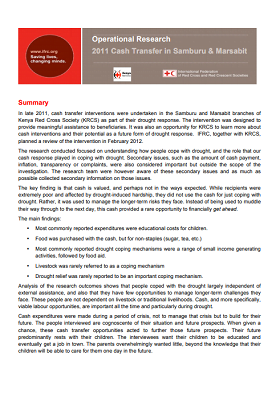
Operational Research: 2011 cash transfer in Samburu & Marsabit
Case Study
In late 2011, cash transfer interventions were undertaken in the Samburu and Marsabit branches of Kenya Red Cross Society (KRCS) as part of their drought response. The intervention was designed to provide meaningful assistance to beneficiaries. It was also an opportunity for KRCS to learn more about cash...

How to Conduct a Trader Survey?
Guidelines and Tools
The purpose of this technical guidance sheet is to provide guidance to WFP Country Office and partner staff in conducting a simple trader survey with limited or no external technical support. For complex trader surveys, or in situations where local capacity is insufficient, experienced WFP staff in the...

New Technologies in Cash Transfer Programming and Humanitarian Assistance
Report
This study was commissioned by the the CALP Network in 2011, to review the current use of new technology in humanitarian cash and voucher programming and the broader implications for humanitarian practice. The research was undertaken to explore (i) preconditions for the use of technological...
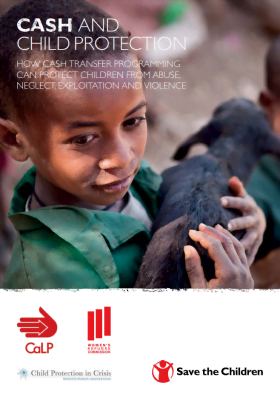
Cash and Child Protection: How cash transfer programming can protect children from abuse, neglect, exploitation and violence
Guidelines and Tools
This discussion paper examines the links between cash transfers and the positive and negative outcomes for children – in particular, the role cash transfers have played in protecting children from abuse, neglect, exploitation and violence. It aims to identify ways in which cash transfer activities could...
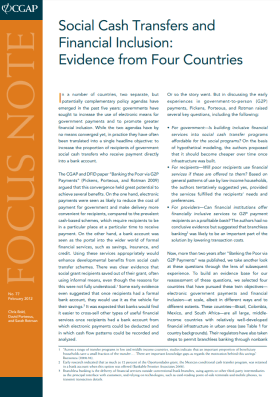
Social Cash Transfers and Financial Inclusion: Evidence from four countries
Report
This focus note from CGAP looks at social cash transfers and how this is being used to improve financial inclusion. To do so they look at examples from Brazil, Colombia, Mexico and South Africa. The focus note compares the various payment approaches, how these interlink with the respective government...

Emergency Food Security and Livelihoods (EFSL) 48-hour Facilitator’s Materials
Guidelines and Tools
Developed by Oxfam and supporting ECB agencies, the EFSL training materials can be used to train participants to confidently apply the ‘48-hour assessment tool’ to assess the impact of a shock/hazard on an affected population’s food security and livelihoods. The Facilitator Materials include session...

Mobile Technology in Emergencies
Policy paper
Mobile phones are increasingly accessible to those affected by crisis and can play a strategic role in the delivery of rapid, cost-effective, scalable humanitarian assistance. However, the full potential of mobile phones to work as transformative tools in emergency response has not yet been realised. This...